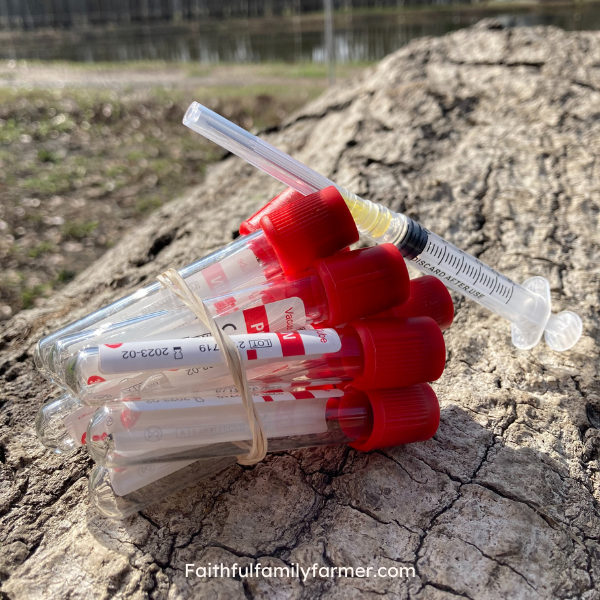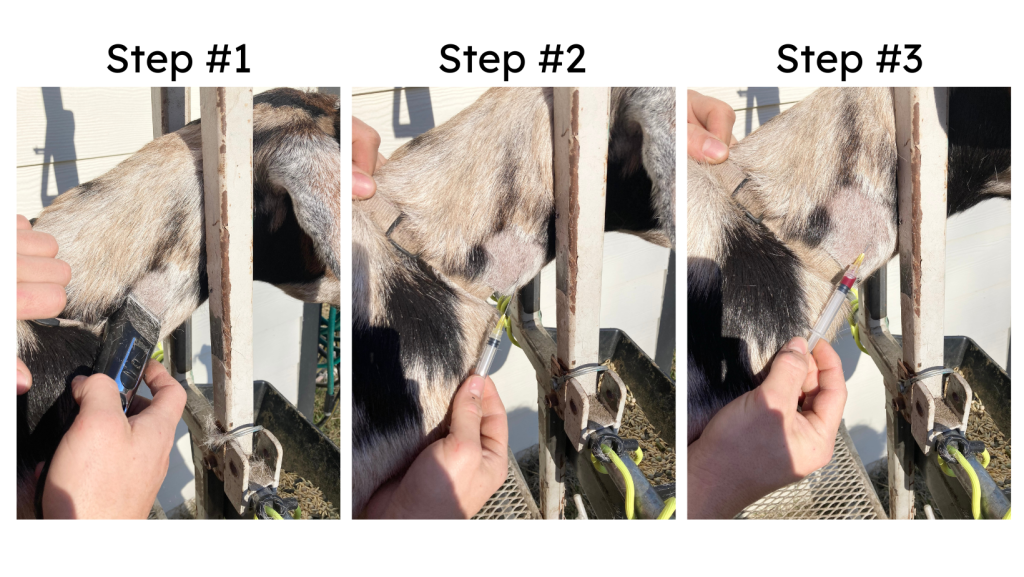How to Blood Test Your Goats
Blood testing goats is something every goat owner should do. In my personal experience, it was a learning curve for sure. It did turn out to be a super simple process (probably because my husband does it). But, No matter who does it, it is intimidating to draw blood on your animal. It is also a challenge to learn the best way to package the samples to make sure they get to the lab safe and on time. Here I’ll show you how to draw blood from your goat so you can be confident when your annual testing day comes around. Already know the info and want to skip to the tutorial, click here.

Why Should I Blood Test My Goats?
There are many reasons to blood test your goats. The first and most important reason is to make sure your raw milk is as clean and healthy as it can be. Some of these diseases can be passed through the milk. Transferable to humans or not, I would prefer not to have disease in my raw milk. If you are reading this article, I’m sure you want your milk disease free as well.
Another big reason is for your goats longevity and productivity. We want our goats to be happy and lively. We also don’t want these diseases to spread to other farms. The last reason I believe it is important to test your herd is honesty. Some goat breeders sell goats without telling the new owners that the goat is sick. I have heard countless stories on this. I do not like to think negatively about people, but this is an unfortunate truth. Make sure you get your goats from a reputable breeder who tests their herd yearly. Always make sure you know the full status of your goats before bringing it home. If a breeder is not willing to give you information on the testing of an animal, I would look somewhere else. There are many other reasons to test your goats, but these by far are my top three.

What Are My Lab Options?
UBRL– This is my preferred lab. I chose this lab because it was the first lab I heard about. Their website was easy to understand and navigate. This lab also has great customer service. They answered all my questions and concerns, they even followed up after the results were in. They also have test kits you can buy with the red top tubes and needles (which you will need to draw the blood).
WADDL– While I don’t have personal experience with WADDL, this lab has countless testing options for all animals. If I didn’t use UBRL first, I would be using WADDL because they have a variety of testing options. I personally know many people who use this lab and have great experiences.
What is CL in goats?
Caseous lymphadenitis is a bacterial infection caused by Corynebacterium pseudotuberculosis.
What are the symptoms of CL?
The symptoms of CL are superficial or internal abscesses. In many cases this process can continue to occur.
Is CL Transmissible to humans?
CL can transfer to humans if precautions are not taken. If dealing with an abscess, wear protective gloves and clothes.
How does CL spread?
CL is spread from the abscess fluid. The fluid can get on barn materials, other goats and in the soil. It is said that CL can live in the soil for 8 months. For more information on CL, you can read this article.
What is CAE in goats?
CAE also known as caprine arthritis encephalitis. This is a virus affecting goats. This virus affects other small ruminant animals and its general term is, small ruminant lintivirus(SRLV).
What are the symptoms of CAE?
CAE can cause chronic disease, including pneumonia, arthritis, encephalitis and mastitis, in multiple organ systems.
Is CAE Transmissible to humans?
It is said that CAE is not transferable to humans. However, in my opinion, it is transferable to a baby goat through the milk, this means that this virus is in the milk. I would not want to consume this milk just to make sure I am not exposed to anything that could harm my body. This decision is entirely up to you.
How is CAE spread?
CAE can be spread through the milk and colostrum of a nursing goat. This can pass to any goat who consumes the milk of an infected goat. CAE can also be passed through the blood of an infected animal. For more information on CAE, You can read this article.
What is Johne’s in Goats?
Johne’s disease, caused by Mycobacterium avium subspecies paratuberculosis. This bacteria affects the small intestines of all ruminants.
What are the Symptoms Of Johne’s?
The main symptoms of johne’s are chronic diarrhea. This will cause the animal to become malnourished and eventually die.
Is Johne’s Transmissible to humans?
I have heard on many sources that johne’s is rarely transfered to humans. I did happen to find this statement “Mycobacterium avium subsp. paratuberculosis (MAP), a slowly growing mycobacteria, is the etiologic agent. There is also a concern that MAP might be a causative agent of some cases of inflammatory bowel disease in humans, especially Crohn’s disease.” This shows that it could have similar affects in humans, but by a different name.
How Johne’s Spread?
Johne’s spreads through the feces of infected animals. To read more click here or here.
What is Q Fever In Goats?
Q fever is caused by Coxiella burnetii
What are the Symptoms of Q Fever?
Q Fever can cause a goat to become anorexic and have late abortions.
Is Q Fever Transmissible to Humans?
Yes
How is Q Fever Spread?
Q Fever is spread through bodily fluids. It can also spread through inhalation and coming in contact with the infected animal. Q Fever can also be present in the raw milk.
Goat Pregnancy Test
Now, while you are blood testing goats for diseases, you might as well test any suspected does for pregnancy. This is what I do when we test our goats, since we are already sending the samples in. Blood testing goats for pregnancy is the most accurate way to tell if your goat is pregnant. They do have urine tests, but they are not accurate. I have heard countless cases of the urine tests not working. One cool thing about the pregnancy test is that the blood does not have to be iced down when sending in the samples. Goat Pregnancy testing is the most exciting of all goat testing! These are my absolute favorite results to get back, I LOVE my baby goats!
Controversial Topics

In my opinion, there tends to be misinformation everywhere on these topics. I wanted to keep the information simple and informative. There have been conflicting statements when it comes to the transmission of these diseases to humans. Just like I stated before, it is best to test your goats to make sure you have a healthy herd so your raw milk is healthy. Disease in goats should always be treated with caution, whether contagious to humans or not. Once again this is my opinion, it is up to you to decide how you want to handle your goats.
Also another thing I learned that can be confusing to new animal testers is a CL blood test is not as accurate as a pus sample on a present abscess. A Blood test can come back negative and the goat could still have CL. This is the same with Johnes too, The feces or intestine samples are the most accurate to use. This all has to do with the antibodies in the blood. CAE is the most accurate using blood samples. I’ve heard of some farms only test for CAE annually. We personally test for all, this just gives us peace of mind. I feel like I can sleep better at night knowing our farm is as clean and healthy as possible.
Detailed Instructions on How to Draw Blood on Your Goat?
How To Draw Blood on Your Goats

Blood testing goats is something every goat owner should do. In my personal experience, it was a learning curve for sure. It did turn out to be a super simple process. I think this could be because my husband does it. But, No matter who does it, it is intimidating to draw blood on your animal. It is also a challenge to learn the best way to package the samples to make sure they get to the lab safe and on time. I want to show you how to draw blood from your goat so you can be confident when your annual testing day comes around.
Materials
- Red top tubes
- 3ml syringe
- Needle for syringe
- Rubber gloves
- Wipes or paper towels
- Force of Nature (For bleach free clean up)
- Pen for labeling test tubes
Instructions
- Put on Your Rubber Gloves.
- Locate the jugular of your goat
- Shave the area you will be taking the blood.(This is not necessary with experience.)
- Put pressure with a collar to expose the vein
- Clean the insertion area
- Insert needle
- Pull blood into tube
- Relieve pressure of collar
- Wait a second or two with needle in( this will allow blood to stop rushing to the area).
- Take the needle out
- Inject into the red top tube. The vacuum pressure in the tube should pull the blood out of the syringe.
- Clean goat and stand with Force of Nature
- Label tube
- Do not reuse the Needle or syringe.
- Dispose needle and syringe in the proper recommended way.

How To Ship the Blood Samples?
- Bundle the samples with a rubber band (max 10)
- Wrap the samples with paper towels
- Place in a Ziploc bag
- Write BIO HAZARD on the bag
- Wrap with insulation like bubble wrap to protect the tubes.
- Fill out the submission form and put payment in another Ziploc to keep it dry. If paying by card then the invoice will be sent via what ever box you checked on the form
- Add an ice pack in another Ziploc bag to protect everything else from water
- Place everything in the box and wrap in bubble wrap
- Write “EXEMPT ANIMAL SPECIMEN” on the box
- Tape it up
- Send it off
Every Lab is different, but you can find detailed instructions for whoever you want to work with. We use UBRL and this is the link to show you how to get your samples in safely.
I hope you feel more confident to get out there and draw blood on your goats, all by yourself (maybe with the help of your husband like me). You got this! If you have any questions, don’t hesitate to comment below.
Have you tested your goats? Let us know which lab you prefer to use!
